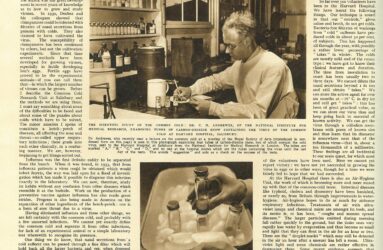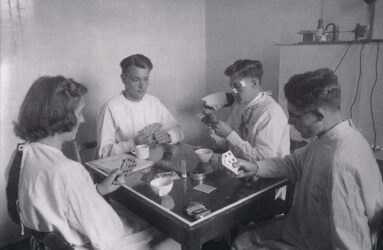
Clinical trials at The Common Cold Unit
The first trial at The Common Cold Unit (Harvard Hospital) began on 17th July 1946.
What were they looking for?
As well as identifying disease, treatment, searching for a vaccine and the relationship between stress and cold symptoms, their research also examined questions such as:
- How are people infected?
- What sort of contact causes this?
- Does sitting in draught make your cold worse?
- Why are colds more common in winter?
Testing
By 1948 they had already received 500 volunteers. Who were either given a saline solution (placebo with no infection) or a virus solution. From this second group around 50% got colds, runny noses after 2-3 days incubation.
The initial testing showed that they were dealing with a virus which is much smaller than bacteria. This was discovered when samples from infected patients were passed through a very fine filter and yet they still passed on symptoms to another test subject.
Coughs & sneezes spread diseases
The tests looked at how heavy particles produced by sneezes fell quickly to the ground, but small ones lose water by evaporation and could float in the air for an hour or two. They also looked at how the virus spreads and saw that shaking a handkerchief was a very effective germ distributor! Therefore, studies went into impregnating these with a disinfectant. Research went into air hygiene treatment of respiratory diseases, effective ways to destroy these with the use of ultraviolet lamps and chemical mists.
Testing transmission of disease
An experiment into contact was described when scientists set running a fluorescent dye from the nose of one of the lab staff whilst they played cards around a table for a short while. After turning off the lights they discovered the dye across the cards, on hands, across the table and spread throughout the room.
David Tyrrell
David Tyrrell (1925-2005) was the researcher who led the Common Cold Unit in Salisbury from 1957 and published over 1000 papers on their discoveries and work there. During his time over 20,000 volunteers took part at guinea pigs and this work identified that the were 100s of different types of cold viruses; Rhinoviruses, Coronaviruses and Parainfluenza.
This was one of the biggest long term research projects, initially looking for viruses it became about vaccines, prevention, immunity and also the psychological factors and whether stress made subjects more susceptible to infection or illness.
Unfortunately, in the 1980s their work became overshadowed by the AIDS crisis and the common cold didn’t seem as important. Without a cure their work seemed like failure. However, when the Unit closed in 1990 this was described as ‘scientific vandalism’ and short-sighted for all the discoveries and medical knowledge that was produced by their work.
The unit closed in 1990 and a housing estate was built on the site. A plaque at the entrance commemorates to 20,000 volunteers who helped with the research, the medical staff and nurses who cared for them.









